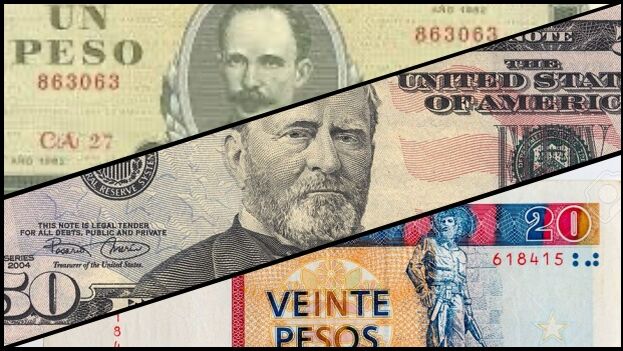
![]() 14ymedio, Yoani Sanchez, Havana, 26 May 2020 – Yesterday I went to bed in a country with dual currency system and today I woke up to the news that we already have a trinity. Little by little, the greenbacks have been gaining space in the Cuban reality and this May 22 the Official Gazette published a resolution that extends the use of the dollar to the network of stores where, until now, one could only make purchases Cuban pesos or Cuban convertible pesos.
14ymedio, Yoani Sanchez, Havana, 26 May 2020 – Yesterday I went to bed in a country with dual currency system and today I woke up to the news that we already have a trinity. Little by little, the greenbacks have been gaining space in the Cuban reality and this May 22 the Official Gazette published a resolution that extends the use of the dollar to the network of stores where, until now, one could only make purchases Cuban pesos or Cuban convertible pesos.
Thirteen years ago, when I launched my blog Generation Y, one of the first texts I wrote was about the economic schizophrenia that had been installed in our lives since the 90s. With a certain irony, I described the need to put each of the currencies in which I was going to pay into a different pocket. If I went to the rationed market, I had to put my hand in the pocket with bills with the faces of Cuban heroes; if I visited a shopping establishment, it was the turn of the bills with the images of monuments. How to go crazy.
The Cuban convertible peso – or chavito, as we call it, or CUC, based on its abbreviation – was intended to be the substitute for the dollar. It came shortly after Fidel Castro – up against the ropes due to the economic crisis of the 90s – authorized “the enemy’s currency” to circulate in the country. Little by little, those colorful bills took precedence over the faces of Lincoln and Washington, but people never fully trusted money that was more reminiscent of a Monopoly game than a serious currency.
Now, the fula – Cuban slang for the dollar – has won the game, after having been the star in the informal market for years, especially when it came to large amounts such as the purchase of a house, the purchase of a car or a payment to obtain an appointment in some of the most in-demand foreign consulates in Havana. Benjamin Franklin’s good-natured face seemed to smile from the paper as he awaited the fall of his awkward substitute, the CUC.
The popular sense of smell, always quick to realize what was coming, has been devaluing the importance of the CUC in most daily transactions. The convertible peso smelled of death a long time ago. “No, I can’t change it for you because we don’t know what is going to happen here,” a fruit vendor from the Youth Labor Army market near my house told me last Friday when I asked her to give me national currency in change for 5 CUC.
The woman does not work at the Central Bank and would probably find it boring to read the complicated language of Resolution 73/2020 published four days ago, in which the flag is raised for “the use of US dollars in foreign currency retail sales operations.” But her experience told her it was a matter of time before it happened. “Since hard currency stores started last year to sell appliances and motorcycles [in dollars], what is missing is for even food to be also sold in dollars,” she warned me.
Today, I remembered her words as soon as I finished reading the document with the official announcement. If, until now, Cuban society was crossed by a line that separated those who received their wages only in Cuban pesos and those who, through tourism, remittances and businesses – legal or illegal – could count on convertible pesos, now there is created another deeper and more decisive division. Those who do not have dollars will have to start looking for them.
All this, in addition, accompanied by a discourse of sovereignty and independence that the national media will continue to repeat even if the money that is most used in the country bears the marks of the United States Federal Reserve. “This won’t last,” the odd youth leader will repeat, while in his wallet Grant’s grim face will be the advance guard that points to the resounding capitulation of his nationalist spirit.
I do not rule out that soon the informal vendors of bread, onions or ice cream sandwiches that pass through my neighborhood will announce their products in fulas. Even rice, which has almost ‘gone missing’ and is a product that is only seen in the rationed or informal market at more than 25 Cuban pesos (CUP) per pound, may perhaps be attracted by the phrase In God We Trust on the back of the dollars. In the end, the motto “Energy Revolution” printed on the 10 CUC bills only recalls a colossal lie.
And now what do we do with the chavitos? Do we save them for the absurd museum that will one day rise on this Island? Or do we put them in a third pocket, the one where everything that does not serve as an exchange for goods or services is put?
______________
COLLABORATE WITH OUR WORK: The 14ymedio team is committed to practicing serious journalism that reflects Cuba’s reality in all its depth. Thank you for joining us on this long journey. We invite you to continue supporting us by becoming a member of 14ymedio now. Together we can continue transforming journalism in Cuba.
